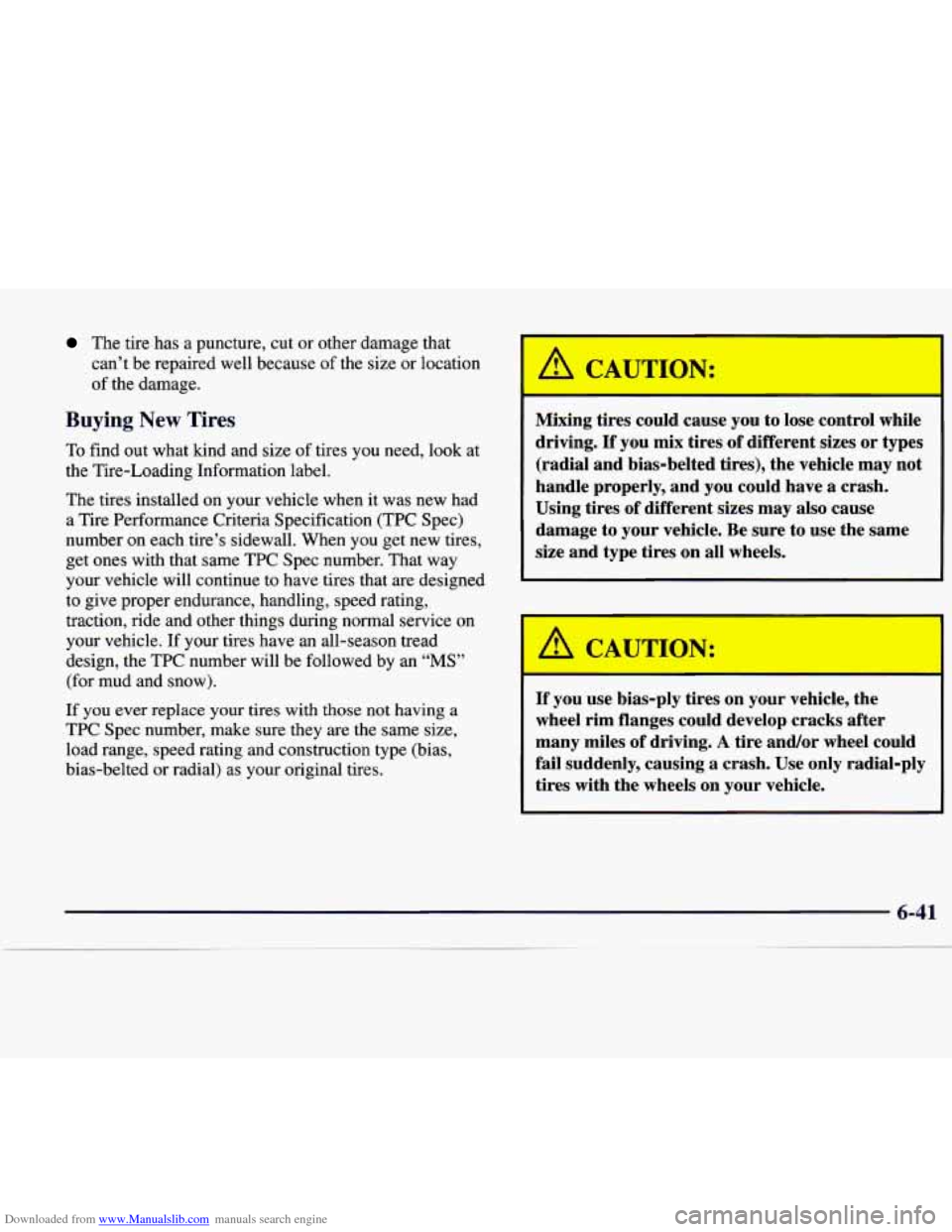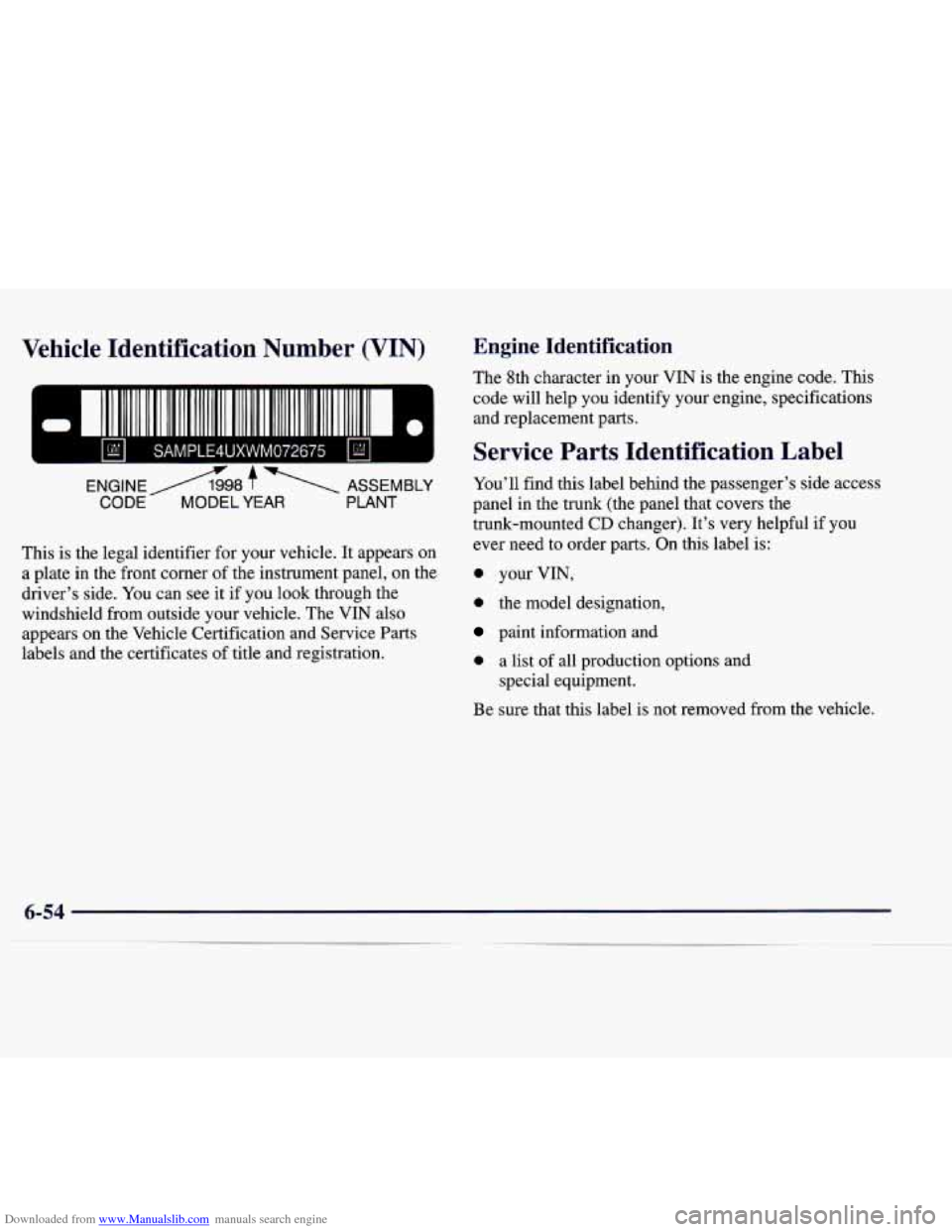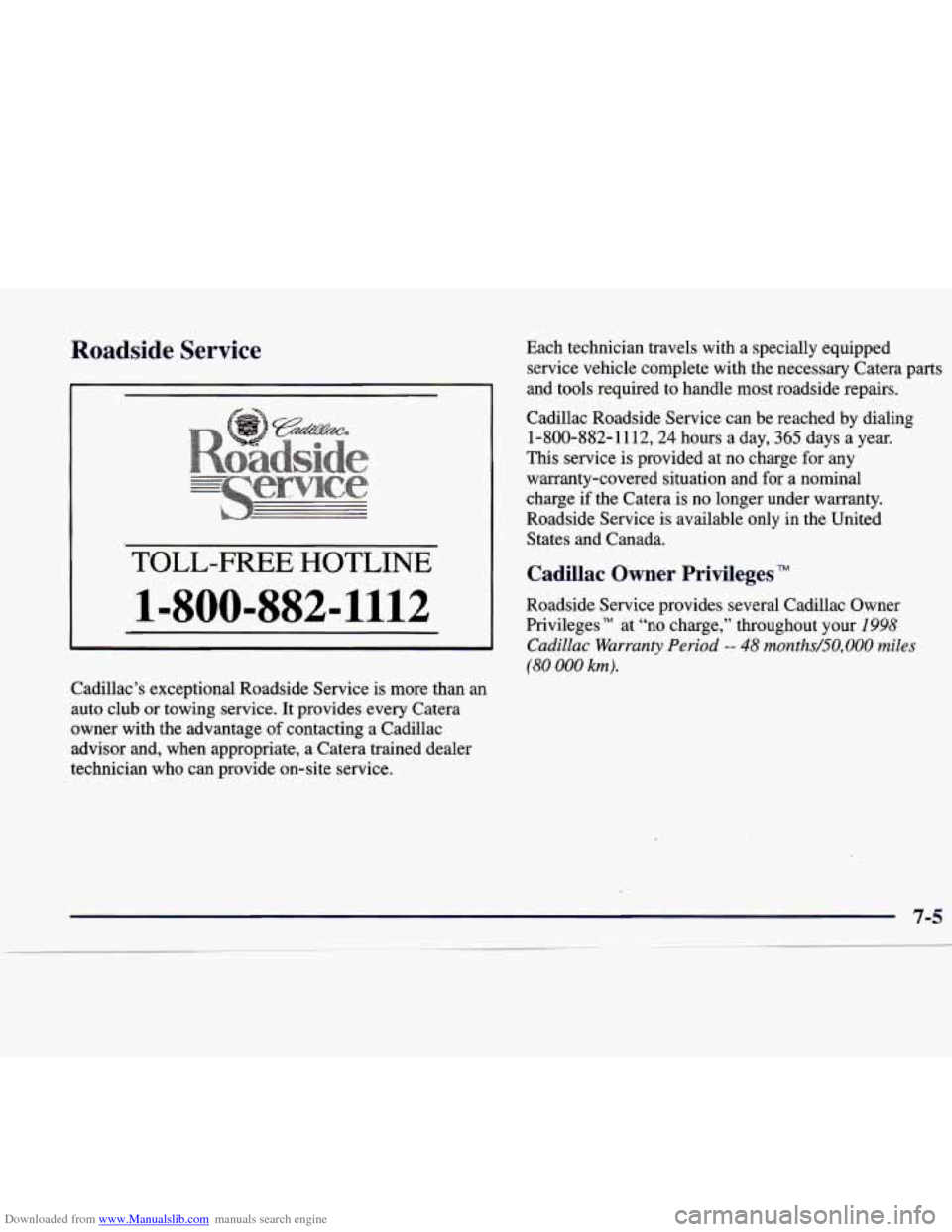Page 288 of 346

Downloaded from www.Manualslib.com manuals search engine When to Check
Check your tires once a month or more. Also, check the
tire pressure of the spare tire.
How to Check
Use a good quality pocket-type gage to check tire
pressure.
You can’t tell if your tires are properly inflated
simply by looking at them. Radial tires may look
properly inflated even when they’re underinflated.
Be sure to put the valve caps back on
the valve stems.
They help prevent leaks by keeping out dirt and moisture.
Tire Inspection and Rotation
Tires should be rotated at 5,000 miles (8 000 km) and
then every
10,000 miles (16 000 km) thereafter. Any
time you notice unusual wear, rotate your tires as soon
as possible and check wheel alignment. Also check for
damaged tires or wheels. See “When It’s Time
for New
Tires” and “Wheel Replacement” later in this section for
more information. The purpose
of regular rotation is to
achieve more
uniform wear for all tires on the vehicle. The first
rotation is the most important. See “Scheduled
Maintenance Services” in the Maintenance Schedule
booklet for scheduled rotation intervals.
7-
When rotating your tires, always use the correct rotation
pattern shown here.
Page 290 of 346

Downloaded from www.Manualslib.com manuals search engine The tire has a puncture, cut or other damage that
can’t be repaired well because of the size or location
of the damage.
Buying New Tires
To find out what kind and size of tires you need, look at
the Tire-Loading Information label.
The tires installed on your vehicle when
it was new had
a Tire Performance Criteria Specification (TPC Spec)
number on each tire’s sidewall. When you get new tires,
get ones with that same TPC Spec number. That way
your vehicle will continue to have tires that are designed
to give proper endurance, handling, speed rating,
traction, ride and other things during normal service on
your vehicle.
If your tires have an all-season tread
design, the TPC number will be followed by
an “MS”
(for mud and snow).
If you ever replace your tires with those not having a
TPC Spec number, make sure they are the same size,
load range, speed rating and construction type (bias,
bias-belted or radial) as your original tires. Mixing
tires could cause you to lose control while
driving.
If you mix tires of different sizes or types
(radial and bias-belted tires), the vehicle may not
handle properly, and you could have
a crash.
Using tires of different sizes may also cause
damage to your vehicle. Be sure to use the same
size and type tires on all wheels.
If you use bias-ply tires on your vehicle, the
wheel rim flanges could develop cracks after
many miles
of driving. A tire and/or wheel could
fail suddenly, causing
a crash. Use only radial-ply
tires with the wheels on your vehicle.
I
Page 291 of 346

Downloaded from www.Manualslib.com manuals search engine Uniform Tire Quality Grading
The following information relates to the system
developed by the United States National Highway
Traffic Safety Administration, which grades tires by
treadwear, traction and temperature performance. (This
applies only to vehicles sold in the United States.) The
grades
are molded on the sidewalls of most passenger
car tires. The Uniform Tire Quality Grading system does
not apply to deep tread, winter-type snow tires,
space-saver or temporary use spare tires, tires with
nominal rim diameters of
10 to 12 inches (25 to 30 cm),
or to some limited-production tires.
While the tires available on General Motors passenger
cars and light trucks
may vary with respect to these
grades, they must also conform to Federal safety
requirements and additional General Motors Tire
Performance Criteria (TPC) standards.
Treadwear
The treadwear grade is a comparative rating based on
the wear rate
of the tire when tested under controlled
conditions on a specified government test course. For
example, a tire graded 150 would wear one and a half
(1
1/2) times as well on the government course as a tire
graded 100. The relative performance
of tires depends
upon the actual conditions of their use, however, and
may depart significantly from the norm due to variations
in driving habits, service practices and differences in
road characteristics and climate.
Traction -- A, B, C
The traction grades, fiom highest to lowest, are A, B, and
C, and they represent the tire’s ability
to stop on wet
pavement
as measured under controlled conditions on
specified government test surfaces of asphalt and concrete.
A tire marked C may have poor traction performance.
Warning: The traction grade assigned to this tire is based
on braking (straight ahead) traction tests and does not
include cornering (turning) traction.
Page 300 of 346
Downloaded from www.Manualslib.com manuals search engine Cleaning Tires
To clean your tires, use a stiff brush with a tire cleaner.
NOTICE:
When applying a tire dressing always take care to
wipe off any overspray or splash from all painted
surfaces on the body or wheels of the vehicle.
Petroleum-based products may damage the
paint finish.
Sheet Metal Damage
If your vehicle is damaged and requires sheet metal
repair or replacement, make sure the body repair shop
applies anti-corrosion material to the
parts repaired or
replaced to restore corrosion protection.
Finish Damage
Any stone chips, fractures or deep scratches in the finish
should be repaired right away. Bare metal will corrode
quickly and may develop into
a major repair expense.
Minor chips and scratches can be repaired with touch-up
materials available from your dealer or other service
outlets. Larger areas of finish damage can be corrected
in your dealer’s body and paint shop.
Page 303 of 346

Downloaded from www.Manualslib.com manuals search engine Vehicle Identification Number (VIN) Engine Identification
The 8th character in your VIN is the engine code. This
code will help you identify your engine, specifications and replacement parts.
m AD A Service Parts Identification Label
ENGlNEbL + ASSEMBLY You’ll find this label behind the passenger’s side access
CODE MODEL YEAR PLANT panel in the trunk (the panel that covers the
trunk-mounted
CD changer). It’s very helpful if you
ever need to order
parts. On this label is:
This is the legal identifier for your vehicle. It appears on
a plate in the front corner
of the instrument panel, on the
driver’s side. You can see it if you look through the
windshield from outside your vehicle. The
VIN also
appears on the Vehicle Certification and Service
Parts
labels and the certificates of title and registration.
- your VIN,
0 the model designation,
paint information and
0 a list of all production options and
special equipment.
Be sure that this label is not removed from the vehicle.
6-54
Page 314 of 346
Downloaded from www.Manualslib.com manuals search engine 6- -A
Section 7 Customer Assistance Information
Here you will find out how to contact Cadillac if you need a\
ssistance. Ths section also tells you how to obtain service
publications and how to report any safety defects.
7-2 Customer Satisfaction Procedure
7-4 Customer Assistance for Text Telephone
(TTY) Users
7-5 Roadside Service
7-7 Roadside Service for the Hearing
or
Speech Impaired
7-8 Gold Key Courtesy Transportation
7-8 Transportation Options
7-1 1 GM Participation in an Alternative Dispute
Resolution Program 7-12
7-
12
7- 13
7- 13
7-13 Warranty
Information
Reporting Safety Defects to the United
States Government
Reporting Safety Defects to the
Canadian Government
Reporting Safety Defects to General Motors
Ordering Service and Owner fiblications
in Canada
Page 315 of 346
Downloaded from www.Manualslib.com manuals search engine Customer Satisfaction Procedure Catera dealers have the facilities, trained technicians and
up-to-date information to promptly address any
concerns you may have. However, if a concern has not
been resolved
to your complete satisfaction, take the
following steps:
STEP ONE -- Discuss your concern with a member
of dealership management. Normally, concerns can
be quickly resolved at that level. If the matter has
already been reviewed with the sales, service or parts
manager, contact the owner of the dealership or the
general manager.
7-2
Page 318 of 346

Downloaded from www.Manualslib.com manuals search engine Roadside Service
[email protected] HOTLINE
1=800-882=1112
Cadillac’s exceptional Roadside Service is more than an
auto club
or towing service. It provides every Catera
owner with the advantage
of contacting a Cadillac
advisor and, when appropriate, a Catera trained dealer
technician who can provide on-site service. Each technician travels with
a specially equipped
service vehicle complete with the necessary Catera parts
and tools required to handle most roadside repairs.
Cadillac Roadside Service can be reached by dialing
1-800-882- 11 12,24 hours a day, 365 days a year.
This service is provided at no charge for any
warranty-covered situation and for a nominal
charge if the Catera is no longer under warranty.
Roadside Service is available only in the United
States and Canada.
Cadillac Owner Privileges TM
Roadside Service provides several Cadillac Owner
Privileges at “no charge,” throughout your
1998
Cadillac Warranty Period
-- 48 months/50.000 miles
(80 000 krn).